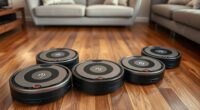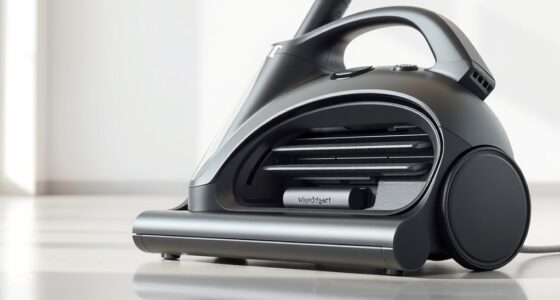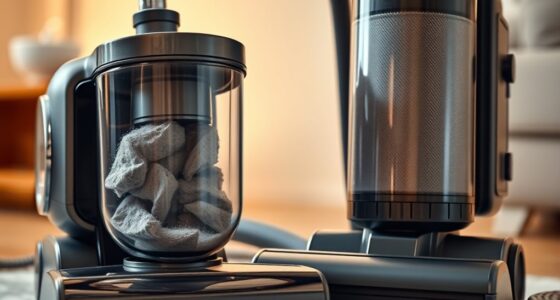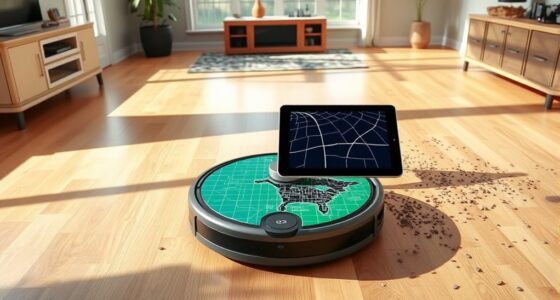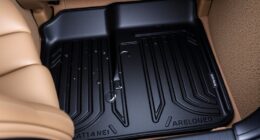Your vacuum’s brush roll speed plays a crucial role in cleaning effectiveness, dust collection, and preserving your machine. Moving too fast can scatter debris and strain the motor, while going too slow might miss dirt or damage delicate surfaces. Adjusting the speed guarantees ideal pick-up without overworking the parts, making your vacuum last longer. If you want to understand how to fine-tune this for different surfaces, there’s more to discover below.
Key Takeaways
- Proper brush roll speed maximizes debris pickup while minimizing scattering and surface damage.
- Adjusting speed balances cleaning effectiveness with motor efficiency and lifespan.
- Faster speeds loosen stubborn dirt but can strain the motor and cause debris scattering.
- Slower speeds protect delicate surfaces and reduce mechanical wear on vacuum components.
- Tailoring brush speed to surfaces enhances overall cleaning performance and vacuum durability.
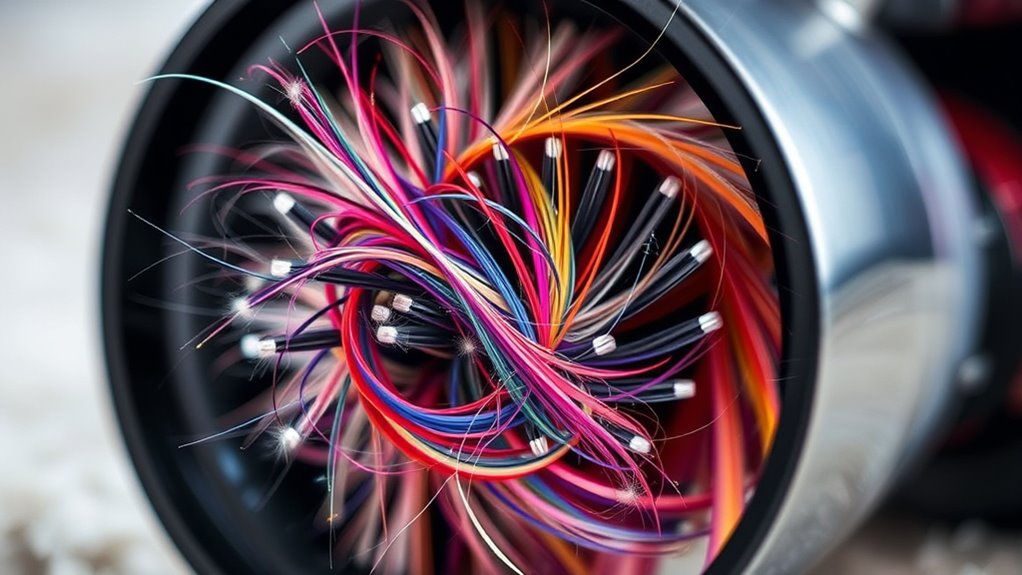
Adjusting the brush roll speed on your vacuum can substantially impact cleaning performance. When you change the speed, you’re directly influencing how well your vacuum picks up dust, dirt, and debris. A faster brush roll can spin through carpets more aggressively, loosening stubborn dirt and ensuring thorough dust collection. Conversely, a slower speed might be better for delicate surfaces or areas where you want to prevent scattering debris. The key is understanding that the right speed maximizes dust collection while protecting your vacuum’s motor efficiency.
Your vacuum’s dust collection depends heavily on the brush roll’s rotation speed. When set correctly, the brush agitates carpet fibers or surfaces, dislodging embedded particles and making them easier for the suction to capture. If the brush roll spins too fast, it can sometimes cause debris to scatter, reducing overall dust collection efficiency. On the other hand, a slower speed may not generate enough agitation to lift dirt effectively, leading to incomplete cleaning. Finding the ideal balance ensures you maximize dust pickup without causing unnecessary mess or overworking your machine.
Motor efficiency is another critical aspect affected by brush roll speed. A high-speed brush can put more strain on the motor, especially if it’s not designed to handle rapid rotation. This overload can lead to overheating or quicker wear and tear, ultimately shortening the lifespan of your vacuum. On the flip side, setting the brush roll too slow might reduce motor load, but it could compromise cleaning quality. Many modern vacuums have adjustable speed settings precisely to help you find that sweet spot, where the motor runs efficiently without sacrificing cleaning power.
Adjusting brush roll speed also helps prolong your vacuum’s lifespan. When you match the speed to the task, you reduce unnecessary stress on the motor and other components. For example, using a lower speed on delicate floors minimizes vibrations and mechanical wear, maintaining motor health over time. This tailored approach not only improves cleaning effectiveness but also preserves your vacuum’s durability, saving you money in repairs and replacements.
Furthermore, understanding the relationship between brush roll speed and cleaning effectiveness enables you to customize your vacuuming strategy for different surfaces and conditions. In essence, the importance of brush roll speed extends beyond just cleaning; it’s about optimizing dust collection and motor efficiency simultaneously. By paying attention to how fast your brush spins, you can fine-tune your vacuum’s performance, ensuring it cleans thoroughly without overburdening its motor. This small adjustment can make a significant difference in your overall cleaning experience, making your vacuum more effective, longer-lasting, and easier to operate.
Frequently Asked Questions
How Does Brush Roll Speed Affect Carpet Durability?
Brush roll speed directly impacts your carpet’s durability by influencing the carpet pile. A faster brush roll can loosen dirt more effectively, but if it’s too fast, it might damage delicate fibers over time. This also affects your vacuum lifespan, as excessive speed strains the motor. Maintaining a suitable brush roll speed ensures thorough cleaning without harming your carpet or shortening your vacuum’s life, keeping both in great condition longer.
Can Adjusting Brush Roll Speed Improve Pet Hair Removal?
Adjusting brush roll speed can markedly boost pet hair removal, making your cleaning more efficient. When you increase the speed, the brush actively lifts stubborn pet hair from carpets and hard floors, reducing buildup and improving removal efficiency. However, faster speeds may cause more noise and wear on carpets over time, and drain your vacuum’s battery faster. Find the perfect balance to keep your home clean without compromising your equipment’s longevity.
Does Higher Brush Roll Speed Increase Noise Levels?
Higher brush roll speeds can increase noise levels, which may impact your user comfort. As the brush spins faster, it creates more sound, potentially making vacuuming less pleasant, especially in quiet environments. If noise levels bother you, consider adjusting the speed or choosing a model with variable speed settings. This way, you can maintain effective cleaning while keeping noise and user comfort in check.
Is Brush Roll Speed Important for Hard Floor Cleaning?
Imagine your vacuum as a skilled painter. When you clean hard floors, a faster brush roll is like quick, precise strokes, boosting cleaning efficiency. It reaches into crevices and lifts debris more effectively. You’ll notice a smoother, more thorough job, especially on tough spots. So yes, brush roll speed is vital for hard floors, helping you achieve cleaner surfaces with less effort.
How Does Brush Roll Speed Impact Vacuum Battery Life?
You might notice that faster brush roll speeds can drain your vacuum’s battery more quickly, impacting battery efficiency. When the brush roll spins faster, the motor has to work harder, which can reduce overall motor performance and cause the battery to deplete faster. To get the best cleaning and battery life, it is crucial to find a balance where the brush roll speed is optimized, ensuring your vacuum runs efficiently without wasting power.
Conclusion
So, next time you’re cleaning, remember—brush roll speed isn’t just a detail; it’s a game-changer. The right speed can mean the difference between a spotless floor and missed spots that hide dirt and debris. But what if there’s more to discover about how speed impacts your cleaning results? Stay curious—because in this simple choice lies the key to truly mastering your cleaning routine, and perhaps, revealing surprises you never expected.

